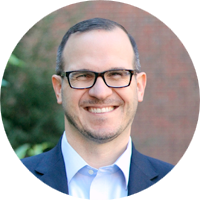

Thought Leadership
October 31, 2025
Weaving Career Education Into the Student Journey: The University of Rochester’s Strategic Approach
Deputy to the President, University of RochesterDiscover how the University of Rochester is strategically embedding career education and amplifying student voices to enhance the overall experience.
Joe Testani, Deputy to the President at the University of Rochester, offered a strategic perspective on enhancing career readiness during an exclusive panel webinar with Kaplan. Key takeaways focus on the importance of amplifying the student voice, providing a clear value proposition, and leveraging innovation to meet the evolving needs of today’s learners. The following excerpts are taken from the interview.

Moving the needle on student success while battling financial barriers, pressures to prove ROI, and evolving student needs can often feel like a daunting undertaking. Especially as students transition from college to career and many are finding it to be an unpredictable job market. Join us for this session that brings together a dynamic panel of higher education leaders who are actively driving gains in student success and career preparedness. Beyond abstract ideas, our panelists will share compelling, real-world examples of programs they've implemented, offering tangible results and practical insights as we collectively think differently about how to best meet the changing demands of today’s learners. Discover groundbreaking programs that are increasing student outcomes and opening new doors of opportunity to achieve dream careers.
Tell us a high-level overview about the University of Rochester and your role there.
Joe Testani: I’m the Deputy to the President at the University of Rochester and I've been working in higher education for over 20 years, mainly in the career education space. This topic of career readiness is near and dear to my heart as I’m always thinking about how we prepare students for their future trajectory once they leave higher education. I've worked in public and private institutions, been a consultant for higher education and EdTech companies and now am the deputy to the president working on the university strategic plan—which has components that focus on experiential learning, student success, preparing the citizens of the future, and what our responsibility is to our students who choose to come to the University of Rochester.
Student success can have different meanings depending on your viewpoint. How do you define “student success” and has that definition shifted over time with students’ evolving needs?
Joe Testani: For us, student success is about holistic support for students. It’s not just getting them through academically and graduating them on time, but weaving in career education and wellness from the first day they arrive here to launching them successfully. Even after that, we believe in supporting them as alumni—whether they go straight to work or go into graduate school.
“Student success is about holistic support for students. It’s not just getting them through academically and graduating them on time, but weaving in career education and wellness from the first day they arrive here to launching them successfully.”
- Joe Testani, Deputy to the President, University of Rochester
That's our contract with our students. It's changed and evolved over the years. Before student success was just about getting them to graduation. Now, it’s about ensuring we give them the wraparound services they need to succeed at school and beyond. Launching them into the world, into their careers, and into their lives as alumni is equally as critical. This enhances the relationship with the institution.
Career readiness is an increasing priority for students. What effective programming are you seeing to address this?
Joe Testani: Three things I’m seeing that have been effective are:
Change in advising
Mentorship
Faculty and academic integration
So, the first item is understanding that students are coming in with so much information on careers, more than ever before. Twenty years ago, they didn't know a lot about different career options. So back then, we were trying to figure out how to bring them that information. Now, information is at their fingertips. They don’t need us to give them information. They need us to help them filter what’s important, what’s meaningful to them, what fits with their values, and figure out what's really resonating.
Second item is mentorship. Getting them connected to people who are doing different careers is critical. That's been a cornerstone of a lot of the work that we've been doing. We're connecting them to our alumni, connecting them to folks who are in industry, who are like them, who map to their identity. These relationships matter and with advances in AI, the human touch is even more important these days in the job search.
Third item is faculty and academic integration. This is one of the big things we've been advocating and pushing for at the University of Rochester. We don't want students to have to opt into career education and think about it as something they should be doing on top of everything else they have responsibility for. Instead, how do we integrate career education into their academic experience? How do we integrate it into their advising experience? That's the most important thing we can do for a lot of our students here.
“We don't want students to have to opt into career education and think about it as something they should be doing on top of everything else they have responsibility for. Instead, how do we integrate career education into their academic experience? How do we integrate it into their advising experience? That's the most important thing we can do for a lot of our students here.”
- Joe Testani, Deputy to the President, University of Rochester
We work with our academic advisors and with our faculty members on this. We've offered grants to faculty members to integrate experiential learning into their courses, elevating the coursework to connect the dots for students so that they're experiencing what it means to be in different industry sectors.
We’re working with our HEOP offices and different offices that target specific populations—our first generation students, our international students—and really considering where the students are showing up and getting good advising. We’re thinking about how do we integrate it into those services so it's more seamless and less that it’s another thing that our students have to do on top of all these other experiences. Faculty are critical. There's a variety of things we're doing to remove that optionality out of it and really embed career decision-making exposure into a lot more of the fabric of a student's experience at the university.
» Related News: The Higher Education Opportunity Program Professional Organization Partners with Kaplan to Offer Free Test Prep for Students at 10 of Its Campuses Across New York State
Do you have advice on getting buy-in from faculty or other departments on campus for career education programs?
Joe Testani: To get buy-in from campus partners, I’ve always focused on surfacing the students' voices. We leaned into amplifying what students want and need and what their expectations were for their education when they arrived at the University of Rochester.
At other institutions I've been to as well, where we've had a lot of first-generation students, we did the same thing. We ask, “Why are students coming to the institution?” How do we surface that voice and that information so that faculty hear it and then can understand how to merge what they do and what they see as their charge, especially at private or smaller liberal arts institutions with the needs that students have?
I see our work as bridges between the faculty and the students. We have a responsibility in the work that we do to amplify the student voice and truly showcase what they are saying and also to bring data to the conversation. In many of the cases, faculty want to see evidence of what we're talking about so it's not only anecdotal.
“We have a responsibility in the work that we do to amplify the student voice and truly showcase what they are saying and also to bring data to the conversation.”
- Joe Testani, Deputy to the President, University of Rochester
We've done needs assessments and surveys for students to be able to tell us what their interests are, and we’ve shown them where our alumni are going as graduates. Then we bring those alumni back to help tell the narrative and their stories to faculty. This has been critical in helping with faculty buy-in.
Do you have any strategies for navigating disengaged students on your campus?
Joe Testani: This is a really interesting question because what we've really tried to lean into is asking, "what's our value proposition?" At the end of the day, you have to ask that question of your office, of your institution, but especially of the functional offices within the university. What value do you offer students? And do they understand that value in relation to other choices that they have?
In the career center where I used to work, we used to think about whether we offer a value that was different from what they could Google. Obviously now, the question would be whether we offer a value different from or beyond what they can get from ChatGPT or Claude. If the answer is no, then that is my competition. It's not the other things on campus. It's that they think they can access information that they need to navigate the job market or look for things somewhere else. And that is a really important reflective exercise that many organizations, staff, and faculty need to do—consider whether or not they are providing a value to students.
Students are looking at their experiences in college from a value proposition perspective. If we start looking at the college experience and what we offer almost like product development, then we can create value or an experience that cuts through the noise.
“Students are looking at their experiences in college from a value proposition perspective. If we start looking at the college experience and what we offer almost like product development, then we can create value or an experience that cuts through the noise.”
- Joe Testani, Deputy to the President, University of Rochester
In looking forward to five years from now, what do you think is higher education's biggest opportunity?
Joe Testani: This is the time where you have to lean into innovation. This is where I always encourage folks to really lean into change management and thinking about how to start understanding what change management is because higher education is at an intersection point with everything that's happening. So, we have to think about what does that look like? How do we adapt and really continue to stay true to the values and the missions that many of us hold dear? How do we do that differently and lean into innovation?
Launch your students successfully to their next step after graduation with access to free test prep and career readiness courses through Kaplan's All Access License®.
All Access License® Success Stories
View all All Access License Resources

Translating Career Readiness to Meet Student Needs: A Conversation with the President of APACS


Building Trust to Enhance Student Success: Insights From HEOPPO’s Aaron Ray
The views and opinions expressed are those of the individuals and not necessarily those of Kaplan. Student experiences may vary.